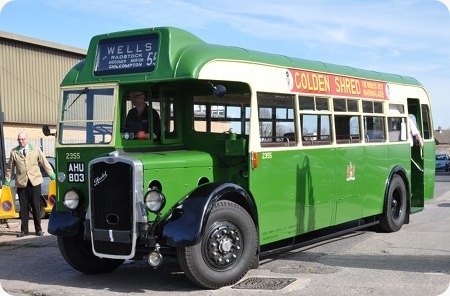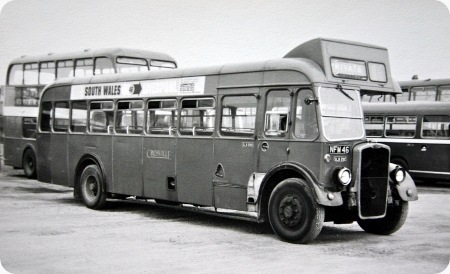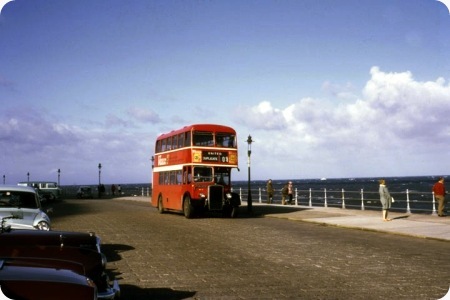Bristol Tramways – Bristol J – AHU 803 – J134-759-2355
Bristol Tramways & Carriage Company Limited
1934
Bristol J
Bristol B35RD
AHU 803 (2355) was built as Bristol J134 in 1934 by the Bristol Tramways and Carriage Company as a private hire coach. It is one of only three preserved Bristol ‘J’ types, and the only one that has been preserved of those that operated with Bristol Tramways.
The vehicle history AHU 803 started life as private hire coach fleet number J134 and apart from a fleet number change in 1937 to 759 remained unchanged until the Second World War. In July 1941 its seating was rearranged to seat 34 while it was used as a bus, and between May 1942 and September 1944 it ran with a gas producer trailer.
After the war a Gardner 5LW diesel engine was fitted replacing the original Bristol 6-cylinder petrol engine and was renumbered 2355 at the same time. Later in 1947 it was rebodied with a new bus body at the operator’s coachworks at Brislington, Bristol. The new body seated 35, and the bus re-entered service in June 1947. In 1958 it was used during the construction of Bristol bus station for carrying large signs with the centre of the roof and rear of the body removed.
It was later sold to Nailsworth Boys’ Club, when a boat rack was carried on the roof, bunk beds and a kitchen were fitted and it was painted in a light blue livery. The vehicle was bought from Nailsworth Boys’ Club in June 1978 and stored for many years in a underground factory. It was then moved to Saltford before moving to Yate goods shed in September 1981 where restoration started. It was moved from Yate to Brislington in February 1993 and restoration was completed during 1999.
Copy by Ken Jones compiled from the Bristol Vintage Bus Group website
13/06/12 – 09:54
Lovely specimen! Thanks for sharing, Ken. Here’s a question. Did this arrangement have a door for the passenger compartment, making it a B..RD or was it just B..R ?
Pete Davies
13/06/12 – 09:54
The history of this bus might suggest that it is a bit or a reconstruction after so many changes but having seen and photographed it on many occasions, it is a superb bus in beautiful condition looking just as it would the day it was new as far as condition goes. Delightful and still in perfect order.
Richard Leaman
13/06/12 – 12:00
What an absolute delight!
I can just hear this bus growling away and would love to hear it in action. It is also quite unusual in having the BBW version of the standard Tilling post war body, which was, I believe, more common in double deck form.
This is quite an early example, before the standardised fitment of the Gardner 5LW, and must have been a JNW (?)
I remember a preserved United Counties J, still with "shield" radiator, but ECW post war body, but where is the other preserved example?
Thanks for a super post!
John Whitaker
13/06/12 – 17:12
May I point you to Gerry Tormey’s website which has details on specifications and survivors of Bristol J vehicles at www.bristolsu.co.uk/ The United Counties vehicle is VV 5696 and the third vehicle is Western National ATT 922. ADV 128 is under restoration.
Ken Jones
13/06/12 – 17:14
In answer to the various questions: yes, the body has a door, so it’s a B35RD. And both comments are right – this isn’t the original body, it’s a replacement dating from 1947; and the original engine was a Bristol JJW petrol engine.
If you’d like to hear it in action (and have a ride on it), then please come along to our rally at Brislington, Bristol on Sunday 12th August 2012, when it will definitely be in action. If you can’t make that, then you should find it at a couple of other events during the year, and either way, more details about events and the bus itself are available on our website, www.bvbg.org.uk
Hope to see you in August!
Chris Knight
14/06/12 – 09:13
Chris-delighted to hear that this Bristol JO5G will be running on the 12 August event. I do hope somebody will do a video clip of a ride of this bus and post it on this web site. I can still recall the sounds of my last service ride on a West Yorkshire Bristol JO5G 979 from Otley to Fewston in the summer of 1954. The combination of a Bristol J with a Gardner 5LW engine and mid-ship mounted gearbox produces a most evocative sound.
Richard Fieldhouse
15/06/12 – 05:42
Chris K… Thank you for answering the question. It looks as if there should be a door – that’s why I asked.
Pete Davies
15/06/12 – 05:43
Richard F… I shall be there on the 12th and will certainly try to get that ride and will indeed make the video film for the Bus Sounds section. Let’s hope it’s a nice sunny day!
Richard Leaman
04/08/12 – 07:53
Can I be difficult and disagree with some of the foregoing.
1. "It is one of only three preserved Bristol J Types" – must be more than that. Tony Brown at Chelvesdon has one, I’ve got two plus there is the one in the picture. Also an H is only a J with a different engine so I think Colin Billinton’s WNOC H ought to be included in the total on the basis that there is no more difference between an H and a J than there is between a JJW and a JO6A for example.
2. "and the only one that has been preserved of those which operated with Bristol Tramways." Don’t think so. One of mine was operated by Tramways.
3. According to my understanding of the standard bodywork nomenclature, the ‘D’ suffix for doors is only normally applied to rear platform double deckers. Looking back at my PSV Circle sheets from those long gone days, Bristol L types, which, so far as I know always sported a sliding platform door always seem to be described as B35R.
Peter Cook
24/09/12 – 17:25
The other Bristol Tramways preserved J is BHW 432, fleet no.2199, which has a 1949 ECW body on a 1935 chassis. I last saw it at Telford, restored as fairground vehicle "Alice".
Western National’s ADV 128 was one of those taken over by Bristol in the 1950 exchange of territory, as no. 2497. I believe this is at Winkleigh.
Geoff Kerr
29/10/14 – 07:05
This was in service last Sunday at BVBG Autumn running day – difficult to imagine it is 80 years old.
Ken Jones
03/02/15 – 05:48
Great to see these buses still in existence. I drove one of these in the sixties for about a year. It was being used to transport workmen to a road construction works in Northern Ireland. It had what I believed to be a 150 Gardner. It also had six volt lights and very slow wipers, a nightmare on wet winter nights. Still I look back on it with fond memories.
Paul Stuart
26/03/16 – 16:51
In 1967 I worked for Dowsett Engineering and we had two Bristols both Coaches I think. One had a beast of an engine in it, a Bristol and the other had a Gardner 6LW and both built like tanks. Lovely coaches, and I’m a Leyland man!
ELJ
27/03/16 – 07:28
Chris K and Peter C: as far as I’m aware, it’s always been PSVC policy to not distinguish between rear-entrance single-deckers with doors, and those without, presumably because, with single-deckers, for many decades doors have been the rule and no doors very much the exception. Looking back now this perhaps seems an omission, but PSVC codes have never catered for all layouts.
As to why doors should be the norm on single-deckers but not double-deckers, I can only think it was because single-deckers were more likely to be used on longer-distance and/or higher speed services.
David Call
12/01/17 – 09:10
Responding to David Call’s comment, firstly, there is of course a third type of entrance for single deckers which seems to have been prevalent prior to approx. 1935 which is a hinged door at the top of the entrance steps which is what AHT pictured above has. I had a sort of feeling these are referred to as vestibuled but I may have dreamed that.
I think the answer to the query about doors being normal on single deckers is that, on the standard ECW bodied L for example, there is a seat right across the back of the bus behind the entrance. If there were no door, the occupant of that seat would get soaked when the bus moved if the rain were coming in the right direction. Notably, single deckers which have no door (for example Exeter 66 (EFJ 666)) have no rear seat.
Peter Cook
13/01/17 – 06:37
Peter
Edinburgh single deckers with open backs had a seat for three at the rear.
Stephen Allcroft
14/01/17 – 07:07
Stephen,
I knew there would turn out to be an exception – to prove the rule of course. Scots must be hardy types. … or maybe being canny Scots the operator didn’t want to lose the fares on 3 seats just because the passengers would get cold and wet.
Peter Cook
Quick links to the - Comments Page - Contact Page - Home Page



